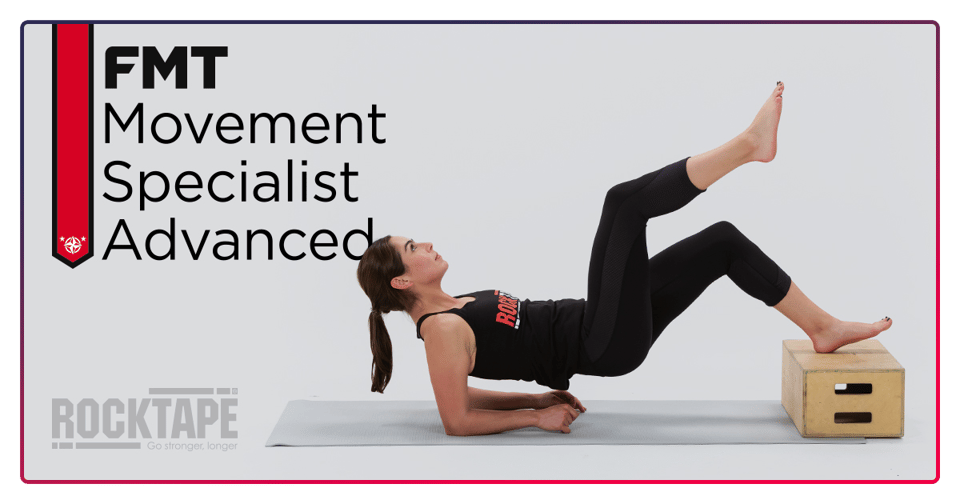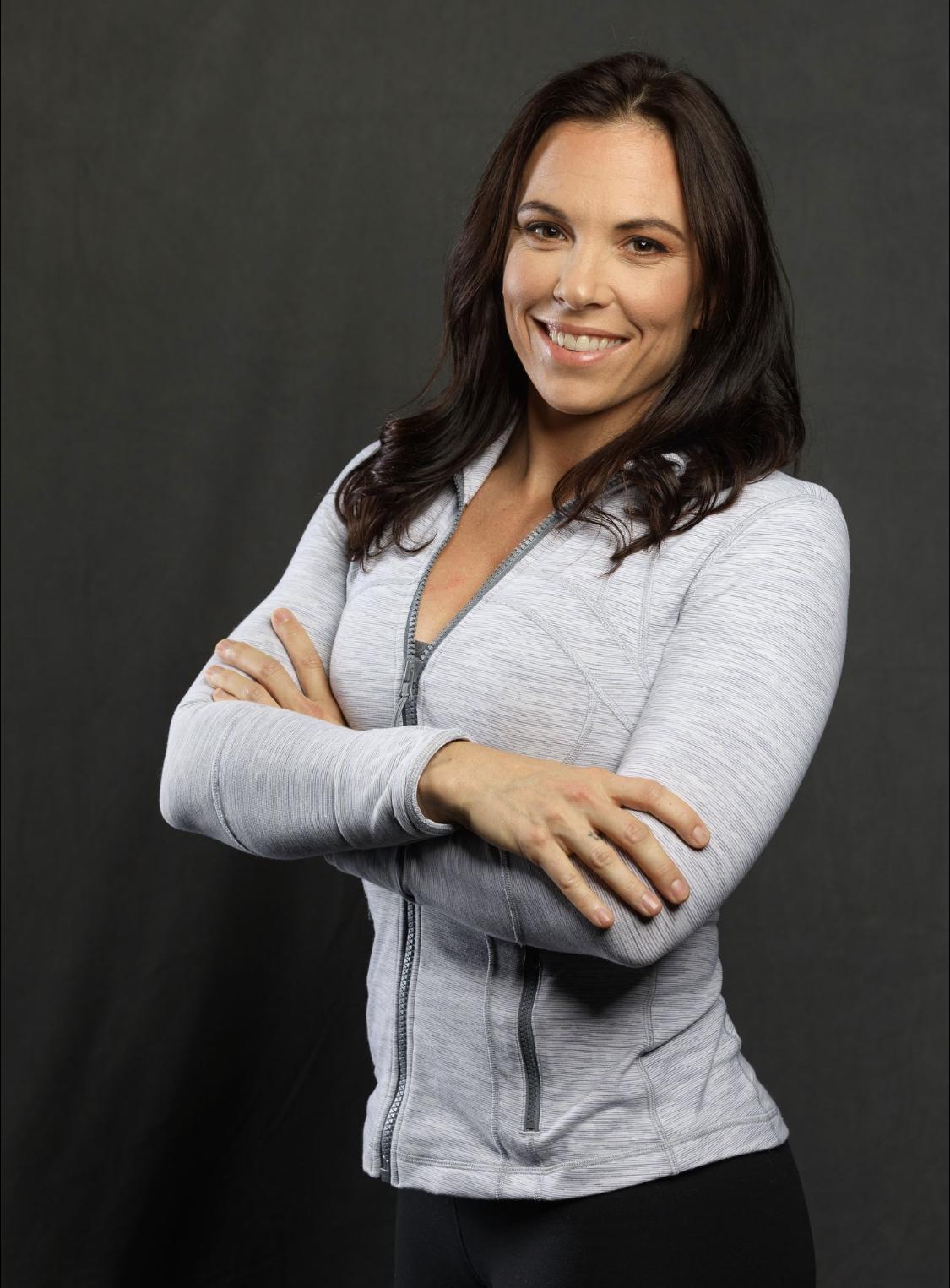RockTape FMT Movement Specialist Advanced
Subconscious Movement Assessment by Dr. Meghan Helwig
Includes all course content in digital format

Description
There is no ‘one size fits all’ to human movement, rather there are many ‘human shapes’ that can accomplish the same movement goals.
More important than stereotypic standards and measurements to ‘ideal’ movements we can provide a more COMPLETE strategy to movement screening by looking at the complete person, their environment and their unique ‘parts’.
FMT Movement Specialist Advanced is designed to help health and fitness professionals learn safe, simple, and effective tactics to screen, assess and address performance of ‘subconscious’movement. Attendees will learn multiple screens and assessments alongside multiple corrective strategies to influence the ‘subconscious’ movements of breathing and gait.
This course offers an evidence-based, functional framework that health and fitness professionals can use to assess and intervene in patients and clients with subconscious movement dysfunction. Topics such as cognitive awareness, neurological, midline and mechanical control and tactical intervention will be discussed and practiced. Lab experiences will include assessment, practice and corrective techniques that will be immediately actionable by students after completion of this training course.
These courses are intended for health and fitness professionals with all levels of prior movement screening experience.
Functional Movement Training (FMT) courses are taught by industry leading experts in movement assessment, performance and rehabilitation. CEUs may be offered for DC, ATC, PT, LMTs, LAc, OTs and personal trainers. If your profession & state is unavailable, we do not currently offer CEUs – however, we are continually adding additional licenses. You can also choose to self-submit to your governing body.
Note: Tools are not provided with this course.
Want to enhance your course experience? You can! here is a list of the suggested material for this course: RockBands, Grid Roller, Floss, MB deep tissue Mobility ball
Expand your knowledge and your practice. Join our Health & Fitness professional program and get up to 50% off every purchase + exclusive benefits! Start saving now!
Learning Objectives
- Evaluate and assess the influence of subconscious capacity on simple human movement patterns.
- Introduce and evaluate breathing screening and assessment strategies.
- Integrate breathing screening/assessment results into corrective programming tactics.
- Compare and contrast methods of coordination and balance assessments as they relate to subconscious movement patterns (Target Movement = Walking Gait).
- Identify and analyze midline control dysfunction in respect to gait and breathing.
- Evaluate and justify differences between joint association vs dissociation.
- Critique and demonstrate gait retraining efforts with a variety of exercise mobility/motor control tools.
- Critique and demonstrate breathing retraining efforts with a variety of exercise mobility/motor control tools.
Course Procedure
This course is 6 hours in length and a 30 Question multiple choice quiz will be required after completing the course to receive your CEU certificate. A 70% test score is required to pass and receive CEUs. The quiz can be open book and unlimited attempts on the quiz are allowed.
Course Content
| FMT Movement Specialist Advanced | Module |
HOUR ONE
- Welcome & introduction of instructor and course participants
- Overview of outline of the course; introduction of topics that will be covered as well as description of practical lab experience and presentation of case studies.
- What is FMT? Functional Movement Training
How do we characterize movement? (Ch 1)
- Movement Chameleon No One Size Fits All Movement Variability
- Conscious vs Subconscious Movement
- Dynamic Systems Theory as it relates to the FMT system of approach
Psycho-social aspects (Ch 2)
- Psychology’s influence on human movement
- Personality’s influence on human movement
- FMT Threat Screen
- Red scoring and score meaning
- Yellow scoring and score meaning
- Green scoring and score meaning
- Discussion of the influence of individuals psychological interpretation of movement as well as their personality traits as it relates to their motivation and learning styles
HOUR TWO
Target Subconscious Movements (Ch 3)
- Breathing: description, relevance
- Gait Cycle: description, relevance
Breathing (Ch 4)
- Breathing Anatomy and Physiology Review
- Motor Control and Breathing
- Pain and Breathing
- Balance and Breathing
- Movement and Breathing
- Gut Mobility and Breathing
Breathing Screening Process (Ch 5)
- Breathing Screen and Scoring of breathing performance
- Lab and instructor feedback
- Breathing Observation for symmetry and dysfunction
- Lab and instructor feedback
- Breathing Pause Hold Assessment and performance of breath pause hold test
- Lab and instructor feedback
- Hi-Low Breathing Assessment and performance of hi lo breathing test
- Lab and instructor feedback
- Breath Wave Assessment and performance of breath wave test
- Lab and instructor feedback
HOUR THREE
Gait Influence on Movement (Ch 6)
- Gait Normal Anatomy and Physiology
- Gait impact on energy conservation
Gait Screening Process (Ch 7)
- Gait Screen: Is gait effective?
- Gait Screen: Is gait efficient?
- Gait Screen: Is gait coordinated?
- Gait Screen: Is gait springy?
- Foot Zone Screen
- Sagittal Screen of foot influence
- Lab and Instructor Feedback
- Frontal Screen of foot influence
- Lab and Instructor Feedback
- Transverse Screen of foot influence
- Lab and Instructor Feedback
- Hip Screen
- Triplanar Screen of Hip Zone and contributions
- Lab and Instructor Feedback
- Shoulder Screen
- Triplanar Screen of Shoulder Zone and contributions
Screening to Assessment (Ch 8)
- Objective testing with digital movement capture
FMT Subsystem Recipe (Ch 9)
- Brain’s influence on human movement, 30,000 ft view
- Midline System’s influence on human movement, 30,000 ft view
- Mechanical influences on human movement, 30,000 ft view
HOUR FOUR
Brain Assessment Corrective Tactics (Ch 10)
- Cerebellum’s influence on correctives
- Ipsilateral Control capabilities in human movement
- Lab and Instructor Feedback
- Coordination and Balance Lab
- Upper Extremity Assessment and Correctives Lab and Instructor Feedback
- Upper Extremity Assessment and Correctives Lab and Instructor Feedback
- Lower Extremity Assessments and Correctives Lab and Instructor Feedback
HOUR FIVE
Midline Assessment Corrective Tactics (Ch 11)
- Planar Controls and how they influence movement
- Sagittal Plane Control Lab and Instructor Feedback
- Breathing Correctives Lab and Instructor Feedback
- Corrective in Quadruped Lab and Instructor Feedback
- Corrective in Standing Lab and Instructor Feedback
- Pursed Lip Lab and Instructor Feedback
- Frontal Plane Control Lab and Instructor Feedback
- Transverse Plane Control Lab and Instructor Feedback
- Midline Stacking Lab and Instructor Feedback
HOUR SIX
Mechanical Assessment Corrective Tactics (Ch 12)
- Joint by Joint approach to movement biomechanical screen
- Block vs Slinky comparison of movement fluidity – Concept of Association/Disassociation
- Foot Zone Association/Disassociation Lab and Instructor Feedback
- Hip/Shoulder Zones Association/Disassociation Lab and Instructor Feedback
Dr. Meghan Helwig

Dr. Meghan Helwig graduated with her Doctorate in Physical Therapy from Rutgers University. A native of Morris County, NJ, Dr. Helwig earned a finance degree from Villanova University where she was the starting goalie for 4 years for the Div. I Big East Field Hockey Team.
An athlete her entire life Dr. Helwig has a competitive mindset and understands the demands sport and life place on the body. She has numerous “tools in her toolbox” and has combined concepts and techniques such as ART, SFMA, NKT, DNS, TPI, Rocktape IASTM/Blades, Kinesiology Taping, and cupping to create her own unique system for assessment and intervention. She utilizes these tools and techniques to assess and treat her patients as a whole while uncovering the underlying “WHY” behind her patients' symptoms.